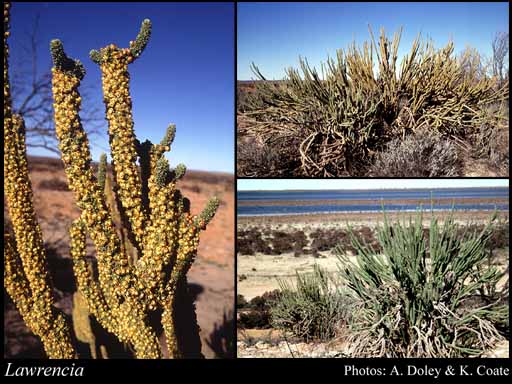- Reference
- Hooker's Icon.Pl. 3:261 (1840)
- Name Status
- Current

Scientific Description
Family Malvaceae.
Tribe Malvaeae.
Habit and leaf form. Shrubs (glabrous or hairy with bifurcate or simple hairs and/or pelate or palmate scales). Plants unarmed. To 0.5–1.8 m high. Mesophytic. Leaves minute to medium-sized; often fasciculate (on much reduced branches); alternate; spiral; petiolate, or subsessile, or sessile; non-sheathing; simple. Leaf blades dorsiventral; dissected (3-lobed), or entire; linear, or ovate, or obovate, or elliptic, or triangular, or orbicular (or spathulate); one-veined, or parallel-veined (3–5 sub-parallel veins); cross-venulate; cordate, or attenuate at the base, or cuneate at the base, or rounded at the base (or truncate). Mature leaf blades adaxially glabrous, or pubescent, or scaly; abaxially glabrous, or pubescent, or scaly. Leaves with stipules (stipules filiform, triangular, elliptic, obovate or sub-orbicular). Stipules intrapetiolar; free of the petiole, or adnate to the petiole (or adnate to the base of the leaf blade of sessile leaves). Leaf blade margins entire, or dentate. Leaf anatomy. Hairs present; complex hairs present.
Reproductive type, pollination. Fertile flowers hermaphrodite (all bisexual flowers are protandrous), or functionally male, or functionally female. Unisexual flowers present. Plants hermaphrodite, or dioecious, or androdioecious (this condition found only in L. glomerata). Entomophilous.
Inflorescence and flower features. Flowers solitary, or aggregated in ‘inflorescences’; axillary. Inflorescence few-flowered (2–5-flowered). Flowers in spikes, or in fascicles. Inflorescences axillary; inflorescence in axillary fascicles often crowded in leafy fascicles forming congested spikes. Flowers subsessile, or sessile; small (male flowers are larger than female flowers); odourless, or fragrant (only in L. berthae); regular; 5 merous; tetracyclic. Hypogynous disk absent. Perianth with distinct calyx and corolla; 10; 2 -whorled; isomerous. Calyx present; 5; 1 -whorled; gamosepalous; lobed; lobulate; erect; valvate and plicate in bud (sepals plicate in bud, lobes valvate in bud); exceeded by the corolla; regular; green; persistent. Calyx lobes triangular. Epicalyx absent. Corolla present; 5; 1 -whorled; gamopetalous (connate at base to form an ovary cup and adnate to the base of the staminal column); lobed; lobulate, or toothed (in male flowers, the lobes are usually lobes spreading and flat and in female flowers the lobes are more or less erect and carinate); imbricate; rotate, or campanulate; usually glabrous abaxially, or hairy abaxially (rarely); usually glabrous adaxially, or hairy adaxially (rarely); with contrasting markings (tinted); green, or white, or cream, or yellow (and tinted red or purple). Petals elliptic, or ovate, or obovate. Androecium present. Androecial members definite in number. Androecium 5–30 (in female flowers the stamens are more or less reduced with anthers absent or fewer in number, smaller and sterile). Androecial members adnate; all equal; coherent (connate; the filaments fused in a column surrounding the style); 1 - adelphous (the tube attached to the petals); 1 -whorled. Androecium exclusively of fertile stamens (or rather, half-stamens, each having only a half anther). Stamens 5–30. Anthers dehiscing via longitudinal slits; introrse; unilocular. Gynoecium 2–11 carpelled. The pistil 2–11 celled. Gynoecium syncarpous; synstylovarious to eu-syncarpous; superior. Ovary plurilocular; 2–11 locular. Gynoecium stylate. Styles 1; forked, or 4-branched, or more than 4-branched (branching from base into 2–11 branches equal in number to the carpels); apical; hairless, or hairy (only in L. berthae). Stigmas 2–11 (decurrent on the style branches); truncate, or clavate. Placentation axile. Ovules 1 per locule; pendulous.
Fruit and seed features. Fruit 1.4–4.7 mm long; non-fleshy; a schizocarp (ovoid or oblong; separating into dehiscent or indehiscent mericarps and leaving a persistent central axis). Mericarps 2–11. Dispersal unit the mericarp. Seeds 1 per mericarp. Seeds endospermic (much reduced); not compressed (reniform in outline); small.
Geography, cytology, number of species. World distribution: Australia. Native of Australia. Endemic to Australia. Australian states and territories: Western Australia, South Australia, Northern Territory, Queensland, New South Wales, Victoria, Australian Capital Territory, and Tasmania. Northern Botanical Province, Eremaean Botanical Province, and South-West Botanical Province. A genus of 12 species; 11 species in Western Australia; 6 endemic to Western Australia.
Additional comments. Etymology: honours Robert William Lawrence (1807–1833), a young settler and botanical collector in the northern part of Tasmania who communicated specimens to Hooker.
Etymology. After Robert William Lawrence (1807–33), collected in Tasmania 1826–33 and transmitted his specimens to Hooker at Kew.
Taxonomic Literature
- Grieve, B. J.; Blackall, W. E. 1998. How to know Western Australian wildflowers : a key to the flora of the extratropical regions of Western Australia. Part II, Dicotyledons (Amaranthaceae to Lythraceae). University of W.A. Press.. Nedlands, W.A..
- Lander, N. S. 1984. Revision of the Australian genus Lawrencia Hook. (Malvaceae: Malvaeae).